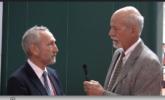Conference Coverage

CPAP fell short for preventing cardiovascular events
Key clinical point: About 3.3.

EXPERT ANALYSIS FROM ATS 2017
WASHINGTON – If patients have sleep disordered breathing with obstructive sleep apnea, will its treatment have cardiovascular disease benefits, especially in terms of the incidence or severity of atrial fibrillation?
Observational evidence suggests that apnea interventions may help these patients, but no clear case yet exists to prove that a breathing intervention works, experts say, and, as a result, U.S. practice is mixed when it comes to using treatment for obstructive sleep apnea (OSA), specifically continuous positive airway pressure (CPAP), to prevent or treat atrial fibrillation.
Results from several retrospective studies all show that, in patients with atrial fibrillation who undergo cardioversion or ablation, those who also have OSA and are treated for their OSA are less likely to have recurrent atrial fibrillation than are patients who are not treated for their OSA. “This has been shown consistently,” with relative risks reduced two- to fourfold in atrial fibrillation patients treated with CPAP, compared with similar, untreated patients, Reena Mehra, MD, a pulmonologist and director of sleep disorders research at the Cleveland Clinic, said in an interview during an international conference of the American Thoracic Society.“The success of pulmonary vein isolation [for resolving atrial fibrillation] is highly influenced by OSA. You can improve the success of pulmonary vein isolation if you treat OSA patients with CPAP. That’s an established benefit,” agreed Olaf Oldenburg, MD, a cardiologist and sleep disorders physician at the Heart and Diabetes Center of Ruhr University in Bad Oeynhausen, Germany. Dr. Oldenburg also agreed that the application of this approach in routine practice has been very spotty.“Only a very small number of patients with atrial fibrillation undergo a sleep study,” he said in an interview. “Before I’d send my mother for atrial fibrillation ablation, I would first look for sleep disordered breathing [SDB],” but this generally isn’t happening routinely. Patients with other types of cardiovascular disease who could potentially benefit from sleep disordered breathing diagnosis and treatment are those with hypertension, especially patients who don’t fully respond to three or more antihypertensive drugs and patients with heart failure with preserved ejection fraction, he added.
Dr. Oldenburg also echoed Dr. Mehra in saying that the evidence supporting this approach for managing atrial fibrillation is less than conclusive.
“We need more precise phenotyping of patients” to better focus on patients with cardiovascular disease and sleep disordered breathing who clearly benefit from CPAP intervention, he said.
Results from the Sleep Apnea Cardiovascular Endpoints (SAVE) trial, reported in September 2016, especially tarnished the notion that treating sleep disordered breathing in patients with various cardiovascular diseases can help avoid future cardiovascular events. The multicenter trial enrolled 2,717 adults with moderate to severe obstructive sleep apnea and cardiovascular disease to receive either CPAP plus optimal routine care or optimal routine care only. After an average follow-up of close to 4 years, the patients treated with CPAP showed no benefit in terms of reduced cardiovascular events (N Engl J Med. 2016 Sept 8;375[10]:919-31).
An editorial that ran with this report suggested that the neutral outcome may have occurred because the average nightly duration of CPAP that patients in the trial self administered was just over 3 hours, arguably an inadequate dose. Other possible reasons for the lack of benefit include the time during their sleep cycle when patients administered CPAP (at the start of sleep rather than later) and that CPAP may have a reduced ability to avert new cardiovascular events in patients with established cardiovascular disease (N Engl J Med. 2016 Sept 8;375[8]:994-6).
Regardless of the reasons, the SAVE results, coupled with the neutral results and suggestion of harm from using adaptive servo-ventilation in patients with heart failure with reduced ejection fraction and central sleep apnea in the SERVE-HF trial (N Engl J Med. 2015 Sept 17;373[12]:1095-105), have thrust the management of SDB in patients with cardiovascular disease back to the point where SDB interventions have no well-proven indications for cardiovascular disease patients.
“With the SERVE-HF and SAVE trials not showing benefit, we now have equipoise” for using or not using SDB interventions in these patients, Dr. Mehra said. “It’s not clear that treating OSA improves outcomes. That allows us to randomize patients to a control placebo arm” in future trials.
An important issue in the failure to clearly establish a role for treating OSA in patients with atrial fibrillation or other cardiovascular diseases may have been over reliance on the apnea-hypopnea index (AHI) as the arbiter of OSA severity, Dr. Oldenburg said. “Maybe there are parameters to look at aside from AHI, perhaps hypoxemia burden or desaturation time. AHI is not the whole truth; we need to look at other parameters. AHI may not be the correct metric to look at in patients with various cardiovascular diseases.”
The superiority of other measures for gauging SDB severity was reinforced by new results reported at the meeting. A review of more than 8,000 patients who were free from any heart arrhythmia and who underwent a sleep study at the University of Toronto during 1994-2010 identified 173 who subsequently developed atrial fibrillation. Analysis of the sleep study findings showed that no cut point for AHI, even a rate of more than 30 sleep disruptions an hour, was significantly linked with later onset of atrial fibrillation, reported Tetyana Kendzerska, MD, a sleep researcher at the the Ottawa Hospital Research Institute. However, when evaluated by the amount of time that patients spent asleep with an oxygen saturation level of less than 90%, those with this level of hypoxemia during at least 30% of their sleep had a 2.5-fold higher rate of later hospitalization for atrial fibrillation, compared with the patients with a lesser burden of nocturnal hypoxemia, in a model that adjusted for several baseline demographic and clinical differences, Dr. Kendzerska said. Among the 8,256 patients she reviewed, 6% fell into this group, with meaningful oxygen desaturation during more than 30% of their time asleep.Her analysis also showed that patients with at least 10 minutes of sleep time with an oxygen saturation rate of 90% or less had a 64% increased rate of later atrial fibrillation hospitalizations, compared with those with fewer than 10 minutes spent in this state. Nearly a quarter of the patients studied fell into this category.
“Nocturnal oxygen desaturation may be stronger than AHI for predicting atrial fibrillation development,” Dr. Kendzerska concluded. “The severity of OSA-related intermittent hypoxia may be more important than sleep fragmentation in the development of atrial fibrillation. These findings support a relationship between OSA, chronic nocturnal hypoxemia, and new onset atrial fibrillation.”
However, using oxygen desaturation instead of AHI to gauge the severity of OSA won’t solve all the challenges that sleep researchers currently face in trying to determine the efficacy of breathing interventions to prevent or treat cardiovascular disease. In the neutral SAVE trial, researchers used nocturnal oxygen saturation levels to select patients with clinically meaningful OSA.
Dr. Mehra and Dr. Kendzerska had no disclosures. Dr. Oldenburg has received consultant fees, honoraria, and/or research support from ResMed, Respicardia, and Weinmann.
On Twitter @mitchelzoler
This article was updated on 7/10/17.

Key clinical point: About 3.3.

The latest update to U.S. guidelines for heart failure management, released at the end of April , puts unprecedented emphasis on heart failure...
